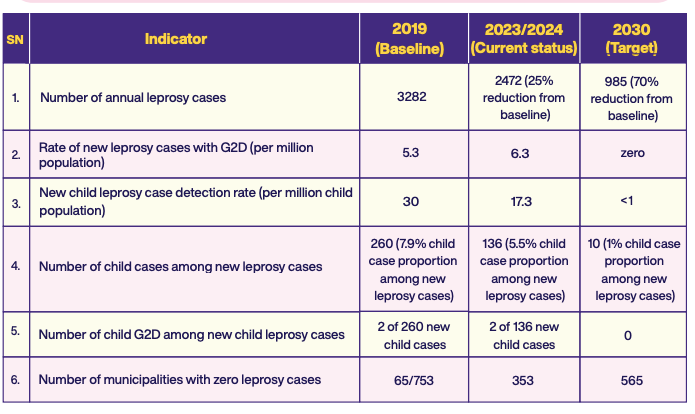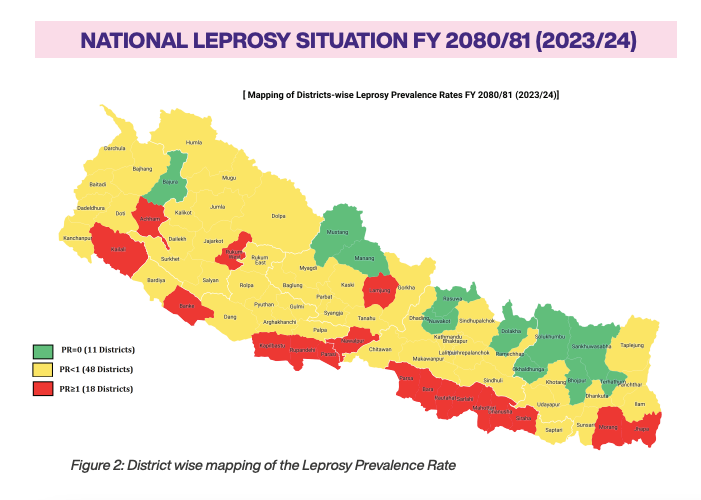What basic facts you need to know ?
- Leprosy, also known as Hansen’s disease, is a less infectious disease caused by a type of bacteria, Mycobacterium Leprae.
- The bacteria are transmitted via droplets, from the nose and mouth, during close and frequent contact with untreated people.
- The disease is curable with multidrug therapy. Untreated, leprosy can cause progressive and permanent damage to the skin, nerves, limbs, and eyes.
How was the Global Situation in 2023?
- 184 countries reported leprosy cases.
- 182,815 new cases were detected.
- 72% (131,425) of new cases were reported in the South-East Asia Region.
- 39.8% (72,845) of new cases were among females and 5.6% (10,322) cases were children.
- 5% (9,729) of new cases had disabilities.
- Case detection increased by 5% in 2023 compared with 2022 (174,087 cases).
- At the end of 2023, 172,510 cases were under treatment globally. (WHO)
What were the milestones of the National Leprosy Program, Nepal?
- 1960: Leprosy sample survey conducted by GoN in collaboration with WHO Prevalence of 100,000 leprosy cases were estimated
- 1966: Dapsone monotherapy
- 1982:Multi Drug Therapy (MDT) introduced in Nepal
- 2010: Declaration of elimination as a public health problem at the national level
- 2015: LCD as the Disability Prevention and Rehailitation Focal unit; Introduction of Leprosy Post Exposure Prophylaxis (LPEP)
- 2019: In-depth review of National Leprosy Program
- 2021: National Leprosy Roadmap of Nepal (2021-2030); National Leprosy Strategy (2021-2025).
Where are we now and what we need to achieve by 2030


What are the key achievements?
- Nepal has achieved elimination of leprosy as a public health problem at National level in 2010.
- Government has developed a Roadmap for Zero Leprosy (2021-30) and National leprosy strategy and action plan (2021-2025) aligning to the Global Leprosy Strategy 2021-2030, with a goal of elimination of leprosy (interruption of transmission) at sub-national level (municipality).
- 25% decrease of the number of annual new leprosy cases between 2019 and 2023/24.
- 42% decrease of the new child leprosy case detection rate between 2019 and 2023/24.
- 48% reduction of the Number of child cases among new leprosy cases between 2019 and 2023/24.
- Increase of the number of municipalities with zero leprosy cases from 65 (2019 baseline) to 353 (2023/24).
What are the ongoing Interventions?
- Routine leprosy services are provided at all levels of health facilities.
- Active case detection including contact examinations at high burden areas remains a high priority for the National Leprosy Program.
- The government is providing Multi-Drug Therapy to patients free of costs.
- Reconstructive surgery for patients with disabilities are consistently provided for free .
- The government has endorsed and implemented preventive strategy of post-exposure prophylaxis with single dose rifampicin.
Some Challenges Remain
- Stagnant Leprosy indicators since national level elimination as a public health problem in 2010.
- Inadequate routine surveillance system.
- Inadequate domestic funding- low priority.
- Limited capacity and leprosy expertise.
- Limited access or referral to essential care services for leprosy complications.
- Stigma and discrimination towards people affected by leprosy
What are the Opportunities?
- High level political commitment from MoHP through 20th Global Appeal 2025 to End Stigma and Discrimination against Persons Affected by Leprosy.
- National Leprosy Conference 2025, which will accelerate the current momentum for leprosy elimination.
- Support from Sasakawa Health Foundation and collaboration with other donors and partners.
Way Forward
- Advocate for political commitment to sustain resources for leprosy in integrated context including domestic investment.
- National partnerships for zero leprosy and zero leprosy roadmaps engaging all stakeholders.
- Enhance capacity building in the healthcare system for quality services.
- Strengthen the disease surveillance through Active Case Finding in high endemic districts and local levels.
- Case-based surveillance system including data verification and case validation in endemic districts. Scale up Leprosy Post-Exposure Prophylaxis for prevention of leprosy.
- Intensify actions to reduce stigma and discrimination related to leprosy.
Recommended readings
Related readings
- National Leprosy Strategy(2021-2025)
- Nepal Leprosy Factsheet 2024
- Leprosy Control Programme in Nepal
- World Leprosy Day 2022: #United4Dignity!
- World Leprosy Day 2020 #WorldLeprosyDay
- World Leprosy Day 2021 #BeatLeprosy
- Evolution and milestones of leprosy control programme in Nepal
- World Leprosy Day 2019: Ending Discrimination, Stigma and Prejudice
- World Leprosy Day (63rd) : ‘To live is to help to live’
- Leprosy Control Programme in Nepal
- 79 new leprosy patients found in Siraha
- World Leprosy Day – Accelerating towards a leprosy-free world
- Zero Disabilities in Girls and Boys #WorldLeprosyDay2018
- WHO lauds Global Partnership to Stop Leprosy; will help renew efforts for zero leprosy
- World Leprosy Day (63rd) : ‘To live is to help to live’
- World Leprosy Day
- Political declaration of the fourth high-level meeting of the General Assembly on the prevention and control of NCDs and the promotion of mental health and well-being
- Kathmandu Declaration: Financing for Universal Health Coverage
- The Belém Health Action Plan for the Adaptation of the Health Sector to Climate Change
- Registration Now Open: Delivering for Nutrition in South Asia 2025 – Towards Impact at Scale!
- World Chronic Obstructive Lung Disease (COPD) Day 2025: Short of Breath, Think COPD!


